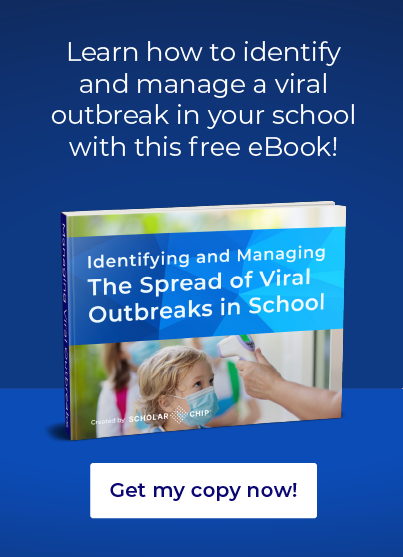Does this situation sound familiar? An illness is common in your community. You ask parents to keep their children home if they’re sick. You also implement strategies that limit spread if a sick student does come to school. These tactics are what you’d use in preventing spread during the annual flu season. COVID-19 is a new illness that is more easily spread than other respiratory illnesses. Also, unlike the flu, people cannot yet be vaccinated for the disease. However, despite these differences, many tactics that schools have taken for years in identifying and managing illness remain similar. That means while COVID-19 is more contagious and less preventable than other illnesses, you can use many of the same strategies to limit its spread. The most significant difference is that stakeholders—including students, staff, and parents—need to take disease prevention more seriously than ever before.
Let’s go over five tactics for identifying and managing illness at your school.
1. Avoid Universal Screening Methods
You may have noticed that businesses have been using temperature screenings to allow visitor entry. However, the Centers for Disease Control and Prevention (CDC) doesn’t recommend this tactic or any type of universal screening for schools.
This is because children are more likely than adults to have mild or entirely asymptomatic cases of COVID-19. Also, any screening test efficient enough to be scalable for your entire population wouldn’t be able to identify all children sick with COVID-19.
2. Teach Parents and Students to Monitor for Signs of COVID-19
Instead of administering a test yourself, teach students and their parents to look out for signs of COVID-19. Again, these symptoms may be very mild in children, so even if a student feels mostly fine, they should still stay home from school. Children’s symptoms should be taken especially seriously if they’ve been in contact with someone who has been diagnosed with the disease.
The COVID-19 symptoms that the CDC lists as common in children are as follows:
- Fever or chills
- Cough
- Shortness of breath or difficulty breathing
- Fatigue
- Muscle or body aches
- Headache
- New loss of taste or smell
- Sore throat
- Congestion or runny nose
- Nausea or vomiting
- Diarrhea
3. Keep Students in Class Pods to Limit Spread
Before COVID-19, students would have moved from classroom to classroom, encountering dozens, if not hundreds, of their peers each day. One of the best ways to limit the spread of COVID-19 is to keep students in smaller classroom cohorts.
In this system, students stay with the same group all day. They remain in the same classroom, with teachers of different subjects traveling to them. To accommodate these different groups, some schools have students attend school for only half the day.
While this cohort system is an effective tactic for illness management, it can be a logistical challenge. ScholarChip’s One Card and Secure Door Access can simplify the complex attendance tracking.
Students each receive a One Card with a unique identification marker. Next, install Secure Door Access card readers at your buildings’ entrances and in front of each classroom door. Students must scan their One Cards when they enter and exit doors and buildings. This way, you can ensure that students aren’t entering spaces that they’re not supposed to be in and that they are leaving campus when they are supposed to.
4. Alter Your Classroom Layouts to Keep Contamination in Check
In addition to creating pods for students, the CDC recommends that you modify your classroom layouts to prevent the spread of illness. This can sometimes mean that fewer students can be in a classroom at a given time, another logistical challenge that the One Card and Secure Door Access system can solve.
The CDC recommends that desks should be kept six feet apart, all facing the front of the room. If these distances can’t be maintained, then barriers should be constructed to prevent contact between students. Furthermore, designated spaces should be marked on the floor so students know how much distance they must keep between each other.
5. Contact Trace to Prevent Potentially Sick Individuals
Contact tracing has proven to be one of the best tactics for slowing the spread of disease. If someone is diagnosed with COVID-19, then a trained team interviews them to figure out with whom they’ve been in contact. Then, the team contacts potentially-infected individuals and encourages them to quarantine for two weeks.
A contact tracing team is a necessary addition to your illness management team. One Cards and Secure Door Access readers simplify contact tracing because they keep records of where students have gone and with whom they’ve interacted.
The final element is ScholarChip’s Visitor Management system. It tracks every person who comes to your campus, where they go, and how long they stay. With this information, your contact tracing team can contact potentially-infected visitors and ensure that they don’t return to campus within COVID-19’s incubation period of two to 14 days.
There are still many unknowns in the future of COVID-19 and schools. However, best practices for identifying and managing illness remain similar to tactics used during a typical flu season. While diligence is needed from parents, faculty, staff, and even students, the spread of COVID-19 can be mitigated using these strategies.
The ScholarChip team is dedicated to helping school leaders maximize the safety and well-being of students and the entire school community.
Now sure what you should do to be able to identify and manage the spread of a viral outbreak in your school or school district? Feel free to chat with one of our school crisis communication specialists today!


